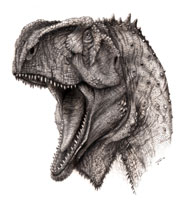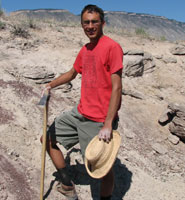The remains of two new 110-million-year-old carnivorous dinosaurs have been named by a student from Bristol University and his former professor from fossils dug up in the Sahara Desert.
Steve Brusatte, who is studying for a MSc in earth sciences, said,
‘For those of us who work on the dinosaurs of the southern continents, uncovering these fossils is like finding a Neanderthal relative to our own species. They are the earliest records of both major carnivore groups that would go on to dominate Africa, South America, and India during the next 50 million years (the Cretaceous period).’
The fossils were discovered by Brusatte’s former research advisor at the University of Chicago, renowned palaeontologist and dinosaur hunter, Dr Paul Sereno. Sereno and Brusatte collaborated on describing the fossils in a paper published this week in the journal Acta Palaeontologica Polonica.
One of the new dinosaurs is a short-snouted Kryptops palaios or ‘old hidden face’, so called for the horny covering on its snout. About 25 feet in length, Kryptops may have scavenged food in the manner of a hyena. Like later members of its group (abelisaurids) in South America and India, it had short, armoured jaws and small teeth, well designed for gobbling guts and gnawing carcasses.
The other discovery is of a similar-sized contemporary, Eocarcharia dinops or ‘fierce-eyed dawn shark’, so called for its blade-shaped teeth and prominent bony eyebrow. Unlike Kryptops, its teeth were more suited to attacking live prey and severing body parts. Carcharodontosaurids, the group to which Eocarcharia belongs, gave rise to the largest predators on southern continents, which were as big or bigger than T-rex. Eocarcharia would have made a terrifying adversary. A swollen bony brow over its eye gave it a menacing appearance and may have been used as a battering ram against rivals for mating rights.
Until now little has been known about the early evolution of these two major southern predator groups of dinosaurs and these discoveries reveal that Kryptops, Eocarcharia and another dinosaur – Suchomimus, a big fish-eating theropod (bipedal, carnivorous dinosaurs) – all lived together and would have made a fearsome three for any plant-eater to face.
Brusatte added,
‘It is clear from their anatomy that they were eating different things: Suchomimus ate fish, Kryptops ate smaller animals and Eocarcharia was the top predator of its day. Just like in the African savannah today, lions, cheetahs and hyenas must eat different food to survive side by side. It is fascinating to see this in a 110-million-year-old ecosystem.’
The fossils were found in the Sahara in 2000 on an expedition led by Sereno and include the jaw bone, pelvic girdle, vertebrae and ribs of Kryptops and several cranial bones and isolated teeth of Eocarcharia. They were recovered from the Elrhaz Formation along the western edge of the Ténéré Desert in Niger in a place known as Gadoufaoua.

